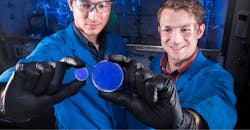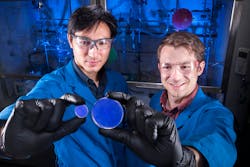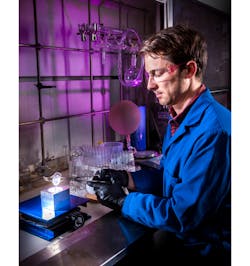Organic Glass Could Lead to Better, Less Expensive Nuclear-Threat Detectors
A team of engineers at Sandia National Labs developed a scintillator made of an organic glass which is more effective and less costly than the current state of the art scintillators made of trans-stilbene ((C6H5CH)2). Scintillators luminesce in the presence of ionizing radiation. And organic glasses are carbon-based materials that can be melted and do not become cloudy or crystallize upon cooling.
The team first designed, synthesized, and assessed new scintillator molecules, hoping to understand the relationship between molecular structures and the resulting radiation detection properties. They were able to find some scintillating materials that could differentiate between nuclear materials which could be potential threats and normal, non-threatening sources of radiation, such as those used for medical treatments or the radiation naturally present in the atmosphere.
Further breakthroughs became possible when the team realized scintillators behave a lot like light-emitting diodes. With LEDs, a known source and amount of electrical energy applied to a device (the LED), and it creates a certain amount of light. In contrast, scintillators create light in response to the presence of an unknown source of radiation source. The source can then be identified based on the amount of light produced and the speed with which it appears.
The gold standard scintillator material for the past 40 years has been the crystalline form of a molecule called trans-stilbene. It is highly effective at differentiating between two types of radiation: gamma rays, which are ubiquitous in the environment, and neutrons, which emanate almost exclusively from controlled threat materials such as plutonium or uranium. Trans-stilbene is sensitive to these materials, generating a bright light in response to their presence. But it takes a lot of energy and several months to produce a trans-stilbene crystal only a few inches long. The crystals are incredibly expensive (around $1,000 per cubic inch) and they’re fragile, so they aren’t commonly used in the field.
Instead, the most common scintillators used to detect nuclear threats at borders and ports of entry use plastic scintillators. They’re inexpensive (less than a dollar per cubic inch) and can be molded into large shapes, which is essential for scintillator sensitivity. As researcher Patrick Feng explains, “The bigger the detector, the more sensitive it’s going to be, because there’s a higher chance radiation will hit it.”
But plastics aren’t able to efficiently differentiate between types of radiation—it takes a separate helium tube to do that. The type of helium used in these tubes is rare, non-renewable, and significantly adds to the cost and complexity of a plastic-scintillator device. And the light plastic scintillators create isn’t particularly bright, at only two-thirds the intensity of trans-stilbene, which means they do not do well at detecting weak radiation sources.
So the Sandia team began experimenting with organic glasses, which can discriminate between types of radiation. In fact, Feng’s team found the glass scintillators are even better the trans-stilbene in radiation detection tests—they are brighter and better at discriminating between types of radiation.
The team faced one major challenge: The initial organic glass compounds were unstable. If they got too hot for too long, they would crystallize, which affected performance. Feng’s team found that blending compounds containing fluorene to the organic glass made them indefinitely stable. The stable glasses could then also be melted and cast into large blocks, which is an easier and less expensive process than making plastics or trans-stilbene. Fluorene also made the glass more transparent and made it emit brighter light in the presence of radiation.
The next step toward commercialization will be casting a large prototype organic glass scintillator for field testing. Feng and his team want to show that organic glass scintillators can withstand the humidity and other environmental conditions found at ports. The team also plans to experiment with organic glass until it can distinguish between gamma-ray sources that are non-threatening and those that can be used to make dirty bombs.



